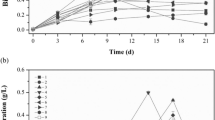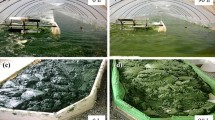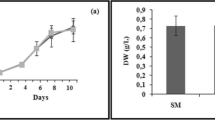Abstract
Carbohydrates are a desirable biomass compound for the generation of several biofuels. Phosphorus nutrient limitation causes a significant increase in the carbohydrate content of the cyanobacterium Arthrospira (Spirulina) platensis. Carbohydrates accumulated up to a content of 63.09 ± 3.43 % (±SD) in both batch and semi-continuous cultures. In order the production of carbohydrate-rich biomass through nutrient limitation to be maximized, it is suggested that the limited nutrients have to be supplied in amounts that they on one hand can support the biomass production while on the other hand they alter the composition of the biomass. In this study, phosphorus of 1.82 ± 0.16 mg g−1 of dry biomass was the optimized amount for the maximization of carbohydrates production by A. platensis. Regarding the need to decrease the application amounts of nutrients for biomass production, this study demonstrates that the phosphorus supply could be decreased an order of magnitude with no significant decrease in biomass production. In addition, it was observed that biomass rich in carbohydrates bio-flocculates, during settling without the addition of any flocculation agent or any other intervention. The bio-flocculation efficiency appears to be related with the carbohydrate content of the biomass. In maximum carbohydrate content (60 %), the biomass bio-flocculated at 68.49 ± 7.73 % the first 15 min and reached 80.25 ± 5.58 % 60 min after settling. The produced carbohydrates might be used as feedstock for biofuel generation, while the bio-flocculation and the overall settling characteristics of the carbohydrate-rich biomass could make its harvesting process much easier.








Similar content being viewed by others
References
Markou G, Georgakakis D (2011) Cultivation of filamentous cyanobacteria (blue-green algae) in agro-industrial wastes and wastewaters: a review. Appl Energ 88(10):3389–3401. doi:10.1016/j.apenergy.2010.12.042
Mata TM, Martins AA, Caetano NS (2010) Microalgae for biodiesel production and other applications: a review. Renew Sustain Energ Rev 14(1):217–232. doi:DOI: 10.1016/j.rser.2009.07.020
Schenk P, Thomas-Hall S, Stephens E, Marx U, Mussgnug J, Posten C et al (2008) Second generation biofuels: high-efficiency microalgae for biodiesel production. Bioenerg Res 1(1):20–43. doi:10.1007/s12155-008-9008-8
Harun R, Jason WSY, Cherrington T, Danquah MK (2010) Microalgal biomass as a cellulosic fermentation feedstock for, bioethanol production. Renew Sust Energ Rev, Uncorrected Proof. doi:10.1016/j.rser.2010.07.071
Zamalloa C, Vulsteke E, Albrecht J, Verstraete W (2011) The techno-economic potential of renewable energy through the anaerobic digestion of microalgae. Bioresour Technol 102(2):1149–1158. doi:10.1016/j.biortech.2010.09.017
Biller P, Ross AB (2011) Potential yields and properties of oil from the hydrothermal liquefaction of microalgae with different biochemical content. Bioresour Technol 102(1):215–225. doi:10.1016/j.biortech.2010.06.028
Heilmann SM, Davis HT, Jader LR, Lefebvre PA, Sadowsky MJ, Schendel FJ et al (2010) Hydrothermal carbonization of microalgae. Biomass Bioenerg 34(6):875–882. doi:DOI: 10.1016/j.biombioe.2010.01.032
Chader S, Mahmah B, Chetehouna K, Amrouche F, Abdeladim K (2011) Biohydrogen production using green microalgae as an approach to operate a small proton exchange membrane fuel cell. Int J Hydrogen Energ 36(6):4089–4093. doi:10.1016/j.ijhydene.2010.07.117
Alvira P, Tomás-Pejó E, Ballesteros M, Negro MJ (2010) Pretreatment technologies for an efficient bioethanol production process based on enzymatic hydrolysis: a review. Bioresour Technol 101(13):4851–4861. doi:10.1016/j.biortech.2009.11.093
Rodjaroen S, Juntawong N, Mahakhant A, Miyamoto K (2007) High biomass production and starch accumulation in native green algal strains and cyanobacterial strains of Thailand. Kasetsart J Nat Sci 41:570–575
Dragone G, Fernandes BD, Abreu AP, Vicente AA, Teixeira JA (2011) Nutrient limitation as a strategy for increasing starch accumulation in microalgae. Appl Energ 88(10):3331–3335. doi:10.1016/j.apenergy.2011.03.012
Brányiková I, Maršálková B, Doucha J, Brányik T, Bišová K, Zachleder V et al (2011) Microalgae—novel highly efficient starch producers. Biotechnol Bioeng 108(4):766–776. doi:10.1002/bit.23016
Dean AP, Estrada B, Nicholson JM, Sigee DC (2008) Molecular response of Anabaena flos-aquae to differing concentrations of phosphorus: a combined fourier transform infrared and X-ray microanalytical study. Phycol Res 56(3):193–201. doi:10.1111/j.1440-1835.2008.00501.x
Warr SRC, Reed RH, Stewart WDP (1985) Carbohydrate accumulation in osmotically stressed cyanobacteria (blue-green algae): interactions of temperature and salinity. New Phytol 100(3):285–292. doi:10.1111/j.1469-8137.1985.tb02779.x
Hu Q (2004) Environmental effects on cell composition. In: Richmond A (ed) Handbook of microalgal culture: biotechnology and applied phycology. Blackwell Publishing Ltd, Oxford
Guerrini F, Cangini M, Boni L, Trost P, Pistocchi R (2000) Metabolic responces of the diatom Achnanthes brevipes (Bacillariophycae) to nutrient limitation. J Phycol 36(5):882–890. doi:10.1046/j.1529-8817.2000.99070.x
Fuhs GW (1969) Phosphorus content and rate of growth in the diatoms Cyclotella nana and Thalassiosira fluviatis. J Phycol 5(4):312–321. doi:10.1111/j.1529-8817.1969.tb02620.x
Kilham S, Kreeger D, Goulden C, Lynn S (1997) Effects of nutrient limitation on biochemical constituents of Ankistrodesmus falcatus. Freshwat Biol 38(3):591–596. doi:10.1046/j.1365-2427.1997.00231.x
Healey FP, Hendzel LL (1975) Effect of phosphorus deficiency on two algae growing in chemostats. J Phycol 11(3):303–309. doi:10.1111/j.1529-8817.1975.tb02784.x
Healey FP (1973) Characterisitcs of phosphorus deficiency in Anabaena. J Phycol 9(4):383–394. doi:10.1111/j.1529-8817.1973.tb04111.x
Cade-Menun BJ, Paytan A (2010) Nutrient temperature and light stress alter phosphorus and carbon forms in culture-grown algae. Mar Chem 121(1–4):27–36. doi:10.1016/j.marchem.2010.03.002
Stehfest K, Toepel J, Wilhelm C (2005) The application of micro-FTIR spectroscopy to analyze nutrient stress-related changes in biomass composition of phytoplankton algae. Plant Physiol Biochem 43(7):717–726. doi:10.1016/j.plaphy.2005.07.001
Dean AP, Nicholson JM, Sigee DC (2008) Impact of phosphorus quota and growth phase on carbon allocation in Chlamydomonas reinhardtii: an FTIR microspectroscopy study. Eur J Phycol 43(4):345–354. doi:10.1080/09670260801979287
Markou G et al (2012) Effects of phosphorus concentration and light intensity on the biomass composition of Arthrospira (Spirulina) platensis. World J Microbiol Biotechnol. doi:10.1007/s11274-012-1076-4
Molina Grima E, Belarbi EH, Acién Fernández FG, Robles Medina A, Chisti Y (2003) Recovery of microalgal biomass and metabolites: process options and economics. Biotechnol Adv 20(7–8):491–515. doi:10.1016/s0734-9750(02)00050-2
Uduman N, Qi Y, Danquah MK, Forde GM, Hoadley A (2010) Dewatering of microalgal cultures: a major bottleneck to algae-based fuels. J Renew Sust Energ 2(1):012701
Christenson L, Sims R (2011) Production and harvesting of microalgae for wastewater treatment, biofuels, and bioproducts. Biotechnol Adv 29(6):686–702. doi:10.1016/j.biotechadv.2011.05.015
Zarrouk C (1966) Contribution a letude d’une cyanophycee. Influence de divers factours physiques. et chimiques sur la croissance et la phytosynthese do Spirulina maxima. Ph.D. thesis, University of Paris, Paris
Leduy A, Therien N (1977) An improved method for optical density measurement of the semimicroscopic blue green alga Spirulina maxima. Biotechnol Bioeng 19(8):1219–1224. doi:10.1002/bit.260190812
Vonshak A (2002) Spirulina platensis (Arthrospira): physiology, cell-biology and biotechnology. Taylor & Francis, London
Lowry OH, Rosebrough NJ, Farr AL, Randall RJ (1951) Protein measurement with the Folin phenol reagent. J Biol Chem 193:265–275
Zöllner N, Kirsch K (1962) Über die quantitative Bestimmung von Lipoiden (Mikromethode) mittels der vielen natürlichen Lipoiden (allen bekannten Plasmalipoiden) gemeinsamen Sulfophosphovanillin-Reaktion. Res Exp Med (Berl) 135(6):545–561. doi:10.1007/bf02045455
APHA (1995) Standard methods for the examination of water and wastewater. American Public Health Association, Washington, DC
DuBois M, Gilles KA, Hamilton JK, Rebers PA, Smith F (1956) Colorimetric method for determination of sugars and related substances. Anal Chem 28(3):350–356. doi:10.1021/ac60111a017
Bezerra RP, Montoya EYO, Sato S, Perego P, de Carvalho JCM, Converti A (2011) Effects of light intensity and dilution rate on the semicontinuous cultivation of Arthrospira (Spirulina) platensis. A kinetic Monod-type approach. Bioresour Technol 102(3):3215–3219. doi:10.1016/j.biortech.2010.11.009
Maier R (2008) Bacterial growth. In: Maier R, Pepper I, Gerba C (eds) Environmental microbiology. Academic, New York, pp 38–56
Schlösser UG (1982) Sammlung von Algenkulturen. Ber Deutsch Bot Ges 95:181–276
Cordell D, Drangert J-O, White S (2009) The story of phosphorus: global food security and food for thought. Global Environ Change 19(2):292–305. doi:10.1016/j.gloenvcha.2008.10.009
Elser JJ (2012) Phosphorus: a limiting nutrient for humanity? Curr Opin Biotechnol. doi:10.1016/j.copbio.2012.03.001
Kering M, Biermacher J, Butler T, Mosali J, Guretzky J (2012) Biomass yield and nutrient responses of switchgrass to phosphorus application. Bioenerg Res 5(1):71–78. doi:10.1007/s12155-011-9174-y
Monti A, Di Virgilio N, Venturi G (2008) Mineral composition and ash content of six major energy crops. Biomass Bioenerg 32(3):216–223. doi:10.1016/j.biombioe.2007.09.012
Tokuşoglu Ö, Ünal MK (2003) Biomass nutrient profiles of three microalgae: Spirulina platensis, Chlorella vulgaris, and Isochrisis galbana. J Food Sci 68(4):1144–1148. doi:10.1111/j.1365-2621.2003.tb09615.x
Blanco-Canqui H (2010) Energy crops and their implications on soil and environment. Agron J 102(2):403–419. doi:10.2134/agronj2009.0333
Powell N, Shilton A, Chisti Y, Pratt S (2009) Towards a luxury uptake process via microalgae—defining the polyphosphate dynamics. Water Res 43(17):4207–4213. doi:10.1016/j.watres.2009.06.011
Valenzuela-Espinoza E, Millán-Núñez R, Núñez-Cebrero F (2002) Protein, carbohydrate, lipid and chlorophyll a content in Isochrysis aff. galbana (clone T-Iso) cultured with a low cost alternative to the f/2 medium. Aquacult Eng 25(4):207–216. doi:10.1016/s0144-8609(01)00084-x
Luque I, Forchhammer K (2008) Nitrogen assimilation and C/N balance sensing. In: Herrero A, Flores E (eds) The cyanobacteria. Molecular biology, genetics and evolution. Caister Academic Press, Norfolk, pp 335–382
Yaşar D (2007) Vitamin E (α-tocopherol) production by the marine microalgae Nannochloropsis oculata (Eustigmatophyceae) in nitrogen limitation. Aquaculture 272(1–4):717–722. doi:10.1016/j.aquaculture.2007.07.213
Orosa M, Valero JF, Herrero C, Abalde J (2001) Comparison of the accumulation of astaxanthin in Haematococcus pluvialis and other green microalgae under N-starvation and high light conditions. Biotechnol Lett 23(13):1079–1085. doi:10.1023/a:1010510508384
Hu Q, Sommerfeld M, Jarvis E, Ghirardi M, Posewitz M, Seibert M et al (2008) Microalgal triacylglycerols as feedstocks for biofuel production: perspectives and advances. PlJ 54(4):621–639. doi:10.1111/j.1365-313X.2008.03492.x
USDOE (2010) National algal biofuels technology roadmap, U.S. Department of Energy, Office of Energy Efficiency and Renewable Energy, Biomass Program
Gómez-Casati DF, Cortassa S, Aon MA, Iglesias AA (2003) Ultrasensitive behavior in the synthesis of storage polysaccharides in cyanobacteria. Planta 216(6):969–975. doi:10.1007/s00425-002-0949-4
Heldt HW, Chon CJ, Maronde D, Herold A, Stankovic ZS, Walker DA et al (1977) Role of orthophosphate and other factors in the regulation of starch formation in leaves and isolated chloroplasts. Plant Physiol 59(6):1146–1155. doi:10.1104/pp. 59.6.1146
Gómez Casati DF, Aon MA, Cortassa S, Iglesias AA (2001) Measurement of the glycogen synthetic pathway in permeabilized cells of cyanobacteria. FEMS Microbiol Lett 194(1):7–11. doi:10.1111/j.1574-6968.2001.tb09438.x
Brennan L, Owende P (2010) Biofuels from microalgae-a review of technologies for production, processing, and extractions of biofuels and co-products. Renew Sustain Energ Rev 14(2):557–577. doi:DOI: 10.1016/j.rser.2009.10.009
Sørensen A, Teller PJ, Hilstrøm T, Ahring BK (2008) Hydrolysis of Miscanthus for bioethanol production using dilute acid presoaking combined with wet explosion pre-treatment and enzymatic treatment. Bioresour Technol 99(14):6602–6607. doi:10.1016/j.biortech.2007.09.091
Chang VS, Kaar WE, Burr B, Holtzapple MT (2001) Simultaneous saccharification and fermentation of lime-treated biomass. Biotechnol Lett 23(16):1327–1333. doi:10.1023/a:1010594027988
Mussgnug JH, Klassen V, Schlüter A, Kruse O (2010) Microalgae as substrates for fermentative biogas production in a combined biorefinery concept. J Biotechnol 150(1):51–56. doi:10.1016/j.jbiotec.2010.07.030
Lavoie A, de la Noüe J (1987) Harvesting of Scenedesmus obliquus in wastewaters: auto- or bioflocculation? Biotechnol Bioeng 30(7):852–859. doi:10.1002/bit.260300707
Van Den Hende S, Vervaeren H, Desmet S, Boon N (2011) Bioflocculation of microalgae and bacteria combined with flue gas to improve sewage treatment. New Biotechnol 29(1):23–31. doi:10.1016/j.nbt.2011.04.009
Papazi A, Makridis P, Divanach P (2010) Harvesting Chlorella minutissima using cell coagulants. J Appl Phycol 22(3):349–355. doi:10.1007/s10811-009-9465-2
Vandamme D, Foubert I, Meesschaert B, Muylaert K (2010) Flocculation of microalgae using cationic starch. J Appl Phycol 22(4):525–530. doi:10.1007/s10811-009-9488-8
de Godos I, Guzman HO, Soto R, García-Encina PA, Becares E, Muñoz R et al (2011) Coagulation/flocculation-based removal of algal-bacterial biomass from piggery wastewater treatment. Bioresour Technol 102(2):923–927. doi:10.1016/j.biortech.2010.09.036
Salim S, Bosma R, Vermuë M, Wijffels R (2010) Harvesting of microalgae by bio-flocculation. J Appl Phycol 23(5):849–855. doi:10.1007/s10811-010-9591-x
Sukenik A, Shelef G (1984) Algal autoflocculation—verification and proposed mechanism. Biotechnol Bioeng 26(2):142–147. doi:10.1002/bit.260260206
Acknowledgments
G. Markou thanks the Greek State Scholarship Foundation (IKY) for its economic support. Dr Despo Kritsotaki and George Kyriakarakos are also acknowledged for their help with English. Authors wish to thank the reviewers for their creative and useful comments.
Author information
Authors and Affiliations
Corresponding author
Rights and permissions
About this article
Cite this article
Markou, G., Chatzipavlidis, I. & Georgakakis, D. Carbohydrates Production and Bio-flocculation Characteristics in Cultures of Arthrospira (Spirulina) platensis: Improvements Through Phosphorus Limitation Process. Bioenerg. Res. 5, 915–925 (2012). https://doi.org/10.1007/s12155-012-9205-3
Published:
Issue Date:
DOI: https://doi.org/10.1007/s12155-012-9205-3




